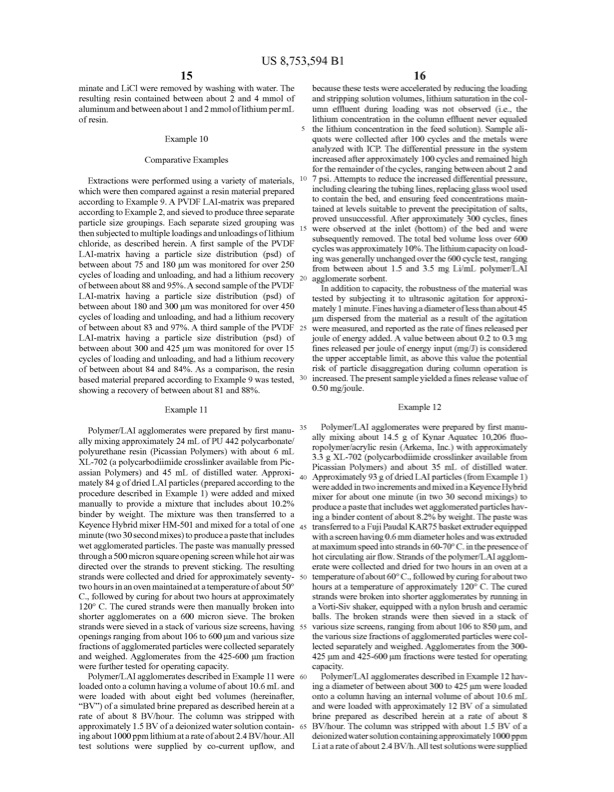
PDF Publication Title:
Text from PDF Page: 012
15 minateandLiClwereremovedbywashingwithwater.The resultingresincontainedbetweenabout2and4mmolof aluminumandbetweenabout1and2mmoloflithiumpermL ofresin. Example10 ComparativeExamples Extractionswereperformedusingavarietyofmaterials,10 whichwerethencomparedagainstaresinmaterialprepared accordingtoExample9.APVDFLAI-matrixwasprepared accordingtoExample2,andsievedtoproducethreseparate particlesizegroupings.Eachseparatesizedgroupingwas thenSubjectedtomultipleloadingsandunloadingsoflithium15 chloride,asdescribedherein.AfirstsampleofthePVDF LAI-matrixhavingaparticlesizedistribution(psd)of betweenabout75and180Lumwasmonitoredforover250 cyclesofloadingandunloading,andhadalithiumrecovery ofbetweenabout88and95%.AsecondsampleofthePVDF LAI-matrix having a particle size distribution (psd) of betweenabout180and300umwasmonitoredforover450 cyclesofloadingandunloading,andhadalithiumrecovery ofbetweenabout83and97%.AthirdsampleofthePVDF 25 LAI-matrixhavingaparticlesizedistribution(psd)of betweenabout300and425umwasmonitoredforover15 cyclesofloadingandunloading,andhadalithiumrecovery ofbetweenabout84and84%.Asacomparison,theresin basedmaterialpreparedaccordingtoExample9wastested,30 showingarecoveryofbetweenabout81and88%. Example1 Polymer/LAIagglomerateswerepreparedbyfirstmanu 35 alymixingapproximately24mLofPU442polycarbonate/ polyurethaneresin(PicasianPolymers)withabout6mL XL-702(apolycarbodiimidecroslinkeravailablefromPic asianPolymers)and45mLofdistiledwater.Approxi mately84gofdriedLAIparticles(preparedaccordingtothe40 proceduredescribedinExample1)wereaddedandmixed manuallytoprovideamixturethatincludesabout10.2% binderbyweight.Themixturewasthentransferedtoa KeyenceHybridmixerHM-501andmixedforatotalofone45 minute(two30secondmixes)toproduceapastethatincludes wetagglomeratedparticles.Thepastewasmanuallypressed througha500micronSquareopeningscreenwhilehotairwas directedoverthestrandstopreventsticking.Theresulting Strandswerecolectedanddriedforapproximatelyseventy50 twohoursinanovenmaintainedatatemperatureofabout50° C.,followedbycuringforabouttwohoursatapproximately 120°C.Thecuredstrandswerethenmanuallybrokeninto shorteragglomeratesona600micronsieve.Thebroken Strandsweresievedinastackofvarioussizescrens,having55 openingsrangingfromabout106to600umandvarioussize fractionsofagglomeratedparticleswerecolectedseparately andweighed.Agglomeratesfromthe425-600umfraction werefurthertestedforoperatingcapacity. Polymer/LAIagglomeratesdescribedinExample1were 60 loadedontoacolumnhavingaVolumeofabout10.6mLand wereloadedwithabouteightbedvolumes(hereinafter, “BV)ofasimulatedbrinepreparedasdescribedhereinata rateofabout8BV/hour.Thecolumnwasstripedwith approximately1.5BVofadeionizedwatersolutioncontain65 ingabout1000ppmlithiumatarateofabout2.4BV/hour.All testSolutionswereSuppliedbyco-curentupflow,and 16 becausethesetestswereaceleratedbyreducingtheloading andstripingSolutionVolumes,lithiumsaturationinthecol umnefluentduringloadingwasnotobserved(i.e.,the lithiumconcentrationinthecolumnefluentneverequaled thelithiumconcentrationinthefeedsolution).Sampleali quotswerecolectedafter100cyclesandthemetalswere analyzedwithICP.Thediferentialpressureinthesystem increasedafterapproximately100cyclesandremainedhigh fortheremainderofthecycles,rangingbetweenabout2and 7psi.Attemptstoreducetheincreaseddiferentialpresure, includingclearingthetubinglines,replacingglaswoolused tocontainthebed,andensuringfeedconcentrationsmain tainedatlevelssuitabletopreventtheprecipitationofsalts, provedunsucesful.Afterapproximately300cycles,fines wereobservedattheinlet(bottom)ofthebedandwere subsequentlyremoved.Thetotalbedvolumelosover600 cycleswasapproximately10%.Thelithiumcapacityonload ingwasgenerallyunchangedoverthe600cycletest,ranging from between about 1.5 and 3.5 mg Li/mL polymer/LAI agglomeratesorbent. Inaditiontocapacity,therobustnessofthematerialwas testedbySubjectingittoultrasonicagitationforapproxi mately1minute.Fineshavingadiameteroflessthanabout45 umdispersedfromthematerialasaresultoftheagitation weremeasured,andreportedastherateoffinesreleasedper jouleofenergyadded.Avaluebetweenabout0.2to0.3mg finesreleasedperjouleofenergyinput(mg/J)isconsidered theupperacceptablelimit,asabovethisvaluethepotential riskofparticledisaggregationduringcolumnoperationis increased.Thepresentsampleyieldedafinesreleasevalueof 0.50mg/joule. Example12 Polymer/LAIagglomerateswerepreparedbyfirstmanu alymixingabout14.5gofKynarAquatec10,206fluo ropolymer/acrylicresin(Arkema,Inc.)withapproximately 3.3gXL-702(polycarbodiimidecroslinkeravailablefrom PicasianPolymers)andabout35mLofdistiledwater. Approximately93gofdriedLAIparticles(fromExample1) wereaddedintwoincrementsandmixedinaKeyenceHybrid mixerforaboutoneminute(intwo30secondmixings)to produceapastethatincludeswetagglomeratedparticleshav ingabindercontentofabout8.2%byweight.Thepastewas transferedtoaFujiPaudalKAR75basketextruderequipped withascreenhaving0.6mmdiameterholesandwasextruded atmaximumspeedintostrandsin60-70°C.inthepresenceof hotcirculatingairflow.Strandsofthepolymer/LAIagglom eratewerecollectedanddriedfortwohoursinanovenata temperatureofabout60°C.,followedbycuringforabouttwo hoursatatemperatureofapproximately120°C.Thecured Strandswerebrokenintoshorteragglomeratesbyrunningin aVorti-SivShaker,equippedwithanylonbrushandceramic balls. The broken strands were then sieved in a stack of varioussizescrens,rangingfromabout106to850um,and thevarioussizefractionsofagglomeratedparticleswerecol lectedseparatelyandweighed.Agglomeratesfromthe300 425umand425-600umfractionsweretestedforoperating capacity. Polymer/LAIagglomeratesdescribedinExample12hav ingadiameterofbetweenabout300to425umwereloaded ontoacolumnhavinganinternalVolumeofabout10.6mL andwereloadedwithapproximately12BVofasimulated brinepreparedasdescribedhereinatarateofabout8 BV/hour.Thecolumnwasstripedwithabout1.5BVofa deionizedwaterSolutioncontainingapproximately1000ppm Liatarateofabout2.4BV/h.Altestsolutionsweresupplied US 8,753,594B1PDF Image | Patent SORBENT FOR LITHIUM EXTRACTION

PDF Search Title:
Patent SORBENT FOR LITHIUM EXTRACTIONOriginal File Name Searched:
US8753594.pdfDIY PDF Search: Google It | Yahoo | Bing
Product and Development Focus for Infinity Turbine
ORC Waste Heat Turbine and ORC System Build Plans: All turbine plans are $10,000 each. This allows you to build a system and then consider licensing for production after you have completed and tested a unit.Redox Flow Battery Technology: With the advent of the new USA tax credits for producing and selling batteries ($35/kW) we are focussing on a simple flow battery using shipping containers as the modular electrolyte storage units with tax credits up to $140,000 per system. Our main focus is on the salt battery. This battery can be used for both thermal and electrical storage applications. We call it the Cogeneration Battery or Cogen Battery. One project is converting salt (brine) based water conditioners to simultaneously produce power. In addition, there are many opportunities to extract Lithium from brine (salt lakes, groundwater, and producer water).Salt water or brine are huge sources for lithium. Most of the worlds lithium is acquired from a brine source. It's even in seawater in a low concentration. Brine is also a byproduct of huge powerplants, which can now use that as an electrolyte and a huge flow battery (which allows storage at the source).We welcome any business and equipment inquiries, as well as licensing our turbines for manufacturing.| CONTACT TEL: 608-238-6001 Email: greg@infinityturbine.com | RSS | AMP |